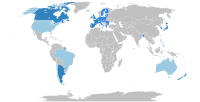
Photo from wikipedia
Abstract Objective: To investigate the effects of providing a daily healthy school snack on children’s nutritional, social and educational outcomes and explore stakeholders’ perceptions of an emergency school feeding programme… Click to show full abstract
Abstract Objective: To investigate the effects of providing a daily healthy school snack on children’s nutritional, social and educational outcomes and explore stakeholders’ perceptions of an emergency school feeding programme (SFP). Design: Convergence triangulation mixed-methods study design. Associations were examined between receiving the school feeding intervention and children’s outcomes using multivariable regression models. Quantitative data were complemented with interviews and focus group discussions with parents and staff. Setting: In vulnerable communities in Lebanon, the World Food Programme has implemented an emergency SFP targeting Lebanese (attending morning sessions) and Syrian refugee children (attending afternoon sessions) in public schools. Participants: Children from ten intervention schools (morning n 403; afternoon n 379) and ten matched control schools (morning n 399; afternoon n 401), as well as twenty-nine parents and twenty-two school staff members. Results: Diet diversity was higher in intervention schools as compared with control with a significantly higher consumption of dairy products, nuts and fruit in both sessions. Child-reported food insecurity experience was lower in children attending the afternoon session of intervention v. control schools. The SFP intervention was associated with higher school engagement and sense of school community in the morning session only. While the SFP was significantly associated with higher attendance for children in afternoon sessions only, it was significantly associated with school retention of children in both sessions. Conclusions: A daily healthy snack potentially acts as an incentive to improve children’s nutritional outcomes, school engagement, sense of belonging, equality between students and improvement in children’s attendance and retention in public schools.
Journal Title: Public Health Nutrition
Year Published: 2022
Link to full text (if available)
Share on Social Media: Sign Up to like & get
recommendations!